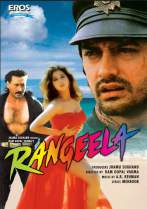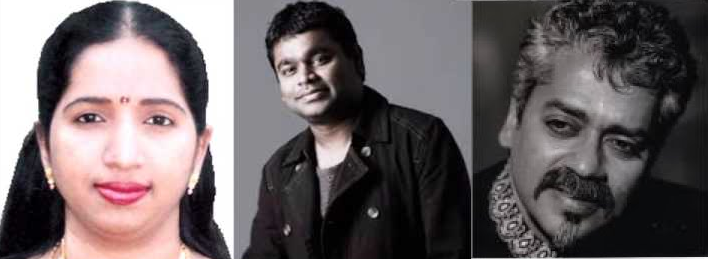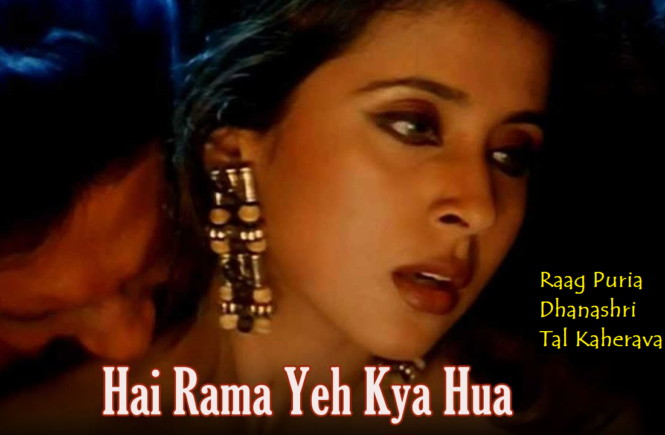Raaga Based Song of the Day: Haay Rama ye kyaa hua…
Raag Puria Dhanashri, Tal Kaherava
We have completed thirty-nine days of Raaga Based Songs of the Day. Our first post in the series was titled ‘Raaga Based Song Of The Day #1’ and the song was a Mohammad Rafi and Lata Mangeshkar song from the 1970 Shakti Samanta movie Pagla Kahin Ka: Tum mujhe youn bhula na paoge. It is in Raag Jhinjhoti, Tal Kaherava.
Our thirty-ninth post was titled ‘Raaga Based Song Of The Day #39’ and the song was a Mohammad Rafi & Manna Dey song from the 1960 RK Rakhan movie Kalpana: Tu hai mera prem devta. It is in Raag Lalit, Tal Tintal.
This blog has a number of posts on Raaga based songs in Hindi movies titled similarly; for example: ‘The Best Raaga Based Songs in Hindi Movies – Raaga Bhimpalasi – Part I‘.
In the last thirty-nine days of sharing Raaga based songs of the day, I have given you songs based on Raag Jhinjhoti, Gara, Bhimpalasi, Madhuvanti, Shivaranjani, Bihag, Pahadi, Sarang, Pilu, Bhairavi, Khammaj, Charukesi, Kalyan or Yaman, Desh, Malgunji, Kirwani, Kedar, Bageshri, Megh Malhar, Bhupali, Ahir Bhairav, Malkaush, Adana, Kafi, Rageshri, Jaunpuri, Tilang, Janasammohini, Chayanat, Shuddha Kalyan, Gaur Sarang, Jogiya, Asavari, Maru Bihag, Durga and Lalit. The only raag that has been repeated so far is Pahadi, the raaga of my home place.
Today, I give you a song in Raag Puria Dhanashri, Tal Kaherava.
However, first, lets take up the value added learning of today. Today, we shall learn about Dadra:
Dadra is a light classical vocal genre of Hindustani music and is very similar to Thumri; one can say that it is actually the faster version of Thumri. This style of singing is mostly prevalent in Agra and Bundelkhand regions. The name Dadra refers to both Dadra as a Tal and as a genre’ of singing.
Dadra Tal consists of six beats in two equal vibhags (Clap, 2,3, Wave, 2,3). The most commonly accepted theka or basic pattern for this tal is Dha Dhin Na, Dha Tin Na. There is a higher emphasis laid on the first swar in comparison the following two, that is, Dha.
I have, in the last 39 days, given you a number of songs in this Tal:
- On 30th May – Maine chand aur sitaaron ki tamanna ki thi. (Raag Bhimpalasi)
- 31st May – Laage na mora jiya. (Raag Shivaranjani)
- 02 June – Tere sur aur mere geet. (Raag Bihag)
- 03 June – Aaj ki raat piya dil na todo. (Raag Pahadi)
- 10 June – Beqasi hadd se jab guzr jaaye. (Raag Desh & Khammaj)
- 16 June – Dukh bhare din beete re bhaiya. (Raag Megh Malhar)
- 01 July – Kesariya baalma. (Raag Mand)
- 12 July – Kuchh aur zamaana kehta hai. (Raag Gaur Sarang)
Dadra genre of singing used to be accompanied by Dadra Tal at one time. But, nowadays, other light tals such as Kaherava are also used.
At this stage, you would want to know if there are any distinctions between Thumri and Dadra. Well, here they are:
- As I have already told you Thumri is slower and Dadra is faster.
- Thumri has lengthy structure of improvisation whereas Dadra is crisp and compact.
- Thumri has lyrics with just two parts: Sthayi and Antara, whereas lyrics of Dadra have more than one Antara.
- Thumri as you know is mostly about human love relationship, whereas Dadra has seasons, nature and human relationships as subjects.
As I mentioned, today’s song is composed in Raag Puria Dhanashri, Tal Kaherava.
Puria Dhanashri is a raaga that belongs to Poorvi Thaat, indeed the type raaga of the Poorvi Thaat. The raaga is derived from the Janak raag. It is a Sampooran-Sampooran (Vakra) raag, that is, it contains all seven notes (ie, Sharaj, Rishabh, Gandhar, Madhyam, Pancham, Dhaivat and Nishad). But the rishabh and the dhaivat are komal both in ascent and descent and the madhyam varies from tivra to shuddh whereas the gandhar and the nishaad stay shudh throughout. It has to be performed in the fourth prahar of the day (3 PM to 6 PM).
Puria Dhanashri is a very compassionate and emotional raaga.
Some of the other songs composed in Raag Puria Dhanashri are: Kitane dino ke baad ye aayi sajana raat milan ki, Koyaliya udd ja yahan nahin koya, Labon se chuum lo aankhon se thaamlo mujhako, Meri saanson ko jo mehkaa rahi hai, Prem lagaana, Rut aa gayi re rut chha gayi re, Teri jai jai kartar, and Tumne kya kya kiya hai hamaare liye.
 I have taken today’s song from the 1995 movie Rangeela, produced and directed by Ram Gopal Verma. The movie starred Aamir Khan, Urmila Mantodkar and Kackie Shroff.
I have taken today’s song from the 1995 movie Rangeela, produced and directed by Ram Gopal Verma. The movie starred Aamir Khan, Urmila Mantodkar and Kackie Shroff.
Aamir Khan plays Munna, a street-toughened orphan, very friendly with a family whose daughter Mili (Urmila Mantondkar) becomes his best friend. Both Munna and Mili have ambitions about Hindi films; Mili wants to be a heroine and Munna sells cinema tickets in black. Whilst dancing once, Mili is observed by a famous actor Raj Kamal (Jackie Shroff). He has her auditioned and she soon lands a role as heroine opposite him. Both Munna and Raj Kamal fall in love with her. In the end, the man from the street, Munna, wins.
Before emerging in this movie as a sensuous heroine, Urmila was a child star in 1983 movie Masoom (Innocent or Naive). The movie posters of Rangeela showed her in revealing scenes with the caption: Masoom, no more. This was one of the two sensuous dances that she did in the movie with Jackie Shroff, whilst they were busy in the shooting of their film Rangeela; the other was: Tanha tanha yahan pe jeena.
The songs of the movie were composed by Oscar winner (for Slumdog Millionaire) AR Rehman and this movie was his debut Hindi movie that catapulted him to great fame. The song was sung by Swaranlatha and Hariharan.

Please enjoy Swaranlatha and Hariharan sing in Raag Puria Dhanashri, Tal Kaherava: Haay Rama ye kyaa hua…….
Haay Raamaa ye kyaa huaa kyo.n aise hame.n sataane lage
(O lord Rama, what has this happened, why have you started toturing me like this?)
Tum itanii pyaarii ho saamane ham qaabuu me.n kaise rahe.n
(You are so much beautiful that in front of you how can i remain in control)
Jaa_o hamako to aatii sharm hai
(Go away, I am taken over by shame)
Terii aisii adaa pe to fidaa ham hai.n
(On your this style, I am attracted to)
Taubaa merii taubaa ye bhii kyaa sitam hai aisii zid karane lage
(O God forbid, what is this atrocity, you are insisting on this?)
Jaane tumane kyaa-kyaa sochaa aage-aage ham to ab Darane lage
(Who knows what all you have thought for things that will happen after that, now I feel afraid)
Are sochaa hai ye ki raat aur din tujhe pyaar kare.nge ham
(O, I have thought that day and night I will love you)
Darate ho kyuu.N o jaan-e-man mere pyaar se
(Why do you feel afraid of my love?)
Kaalii-kaalii zulfe.n gorii-gorii baa.Nhe.n mujhako ta.Dapaane lagii.n
(Your black hairlocks, your fair arms, are seducing me)
Ho.NTh bhiige-bhiige nashiilii ye aa.Nkhe.n pyaas ko jagaane lagii.n
(You wet lips, your intoxicating eyes, are making a thirst grow in me)
Chho.Do jii aisii baato.n ko roko naa raaho.n ko
(Please give up this line of talks, don’t hinder me)
Ho mo.Do naa merii baa.Nho.n ko jaane do naa
(Don’t twist my arms, let me go)
We have intended to learn about Raaga based music whilst we entertain ourselves with Raaga based songs. So, lets, once again, take stock of our collective learning so far:
- On the first day we learnt about the Raaga system devised by Pandit Vishnu Narayan Bhatkhande, which is the prevalent system in Hindustani Classical Music and based on ten Thaats.
- On the second day we learnt about Tal or Taal.
- On the third day we learnt about characteristics of Raagas that included Swar, Jati, Thaat, Arohana and Avarohana, Vadi, Samvadi and Pakad.
- On the fourth day, we learnt about Sargam.
- On the fifth day, we learnt about notations used in Indian classical music or simply Swar Lipi.
- On the sixth day, we learnt about the Ras (sentiments) that Raagas evoke.
- On the seventh day, we learnt about various types of Swar: Shuddha, Achal, Vikrut, Komal and Teevra.
- On the eighth day, we learnt the parts of a composition in Indian Classical Music.
- On the ninth day, we learnt the names of some of the popular instruments used in Indian Classical Music.
- On the tenth day, we learnt about the sources of names of Raagas.
- On the eleventh day, we learnt about why Bhairavi is the first raag to be taught to beginners and also why it is the last in a performance.
- On the twelfth day, we learnt about Khammaj Thaat.
- On the thirteenth day, we learnt about Tal Punjabi Theka or Sitarkhani.
- On the fourteenth day, we learnt about Alap.
- On the fifteenth day, we learnt about List of Raagas (Raagmala) in my favourite book: Sri Guru Granth Sahib.
- On the sixteenth day, we learnt about tips for raaga identification.
- On the seventeenth day, we learnt the basics of Gharana system.
- On the eighteenth day, we learnt about Filmi Sangeet.
- On the nineteenth day, we learnt about the commonest Tal in Raagas: Tintal.
- On the twentieth day, we learnt about the Kafi Thaat.
- On the twenty-first day, we learnt a little more in detail about the classification of Raagas.
- On the twenty-second day, we learnt the essential differences between Bhairavi and Bhairav.
- On the twenty-third day, we learnt a little more in detail about the Jati or Jaati of a raaga.
- On the twenty-fourth day, we learnt details of Thaat Bilawal, the most basic thaat in the Bhatkhande’s system of raagas.
- On the twenty-fifth day, we learnt about Tintal.
- On the twenty-sixth day, we learnt in detail about the Raaga – Samay linkage.
- On the twenty-seventh day, we learnt about Lehar.
- On the twenty-eighth day, we learnt about the history of the Hindustani Music.
- On the twenty-ninth day, we learnt about Dhrupad.
- On the thirtieth day, we learnt about Rupaktal that I was introduced to, a few months back, by my friend Anand Desai.
- On the thirty-first day, we learnt about Khayal.
- On the thirty-second day, we learnt about Thumri.
- On the thirty-third day, we learnt about Tappa.
- On the thirty-fourth day, we learnt about Tarana.
- On the thirty-fifth day, we learnt about Tal Dipchandi (Moghali).
- On the thirty-sixth day, we learnt about Tabla.
- On the thirty-seventh day, we learnt about Kirtan.
- On the thirty-eighth day, we learnt about Pakhawaj.
- On the thirty-ninth day, we learnt about Hori.
- And today, on the fortieth day, we learnt about Dadra.
There is much more still to be learnt and enjoyed.
Please stay tuned!
